The Polish Geological Institute was established in Warsaw, the city where the King Stanisław August Poniatowski created the Natural History Cabinet which included a very important unit concerned with geological investigations for discoveries of natural resources, and founded on April 10, 1782, the Ore Committee - a precursor of the Ministry of Mining, Metallurgy and Geology. The man who significantly contributed to the development of geosciences in Poland was Stanisław Staszic. As the President of the Science Friends Society, he organized and promoted scientific undertakings and initiated broad scale geological and mining investigations. He was also a founder of the Mining School in Kielce.
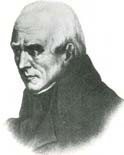 Stanislaw Staszic
Stanislaw StaszicThe first ideas about establishing of a geological institution (Józef Morozewicz, Władysław Szanojcha) arose at the beginning of the 20th century in Polish Galicia, however there was no institution to play a role of a geological survey until the Act of Independence. In 1901, Jan Lewiński, a famous geologist, created the Geological Laboratory at the Industry and Agriculture Museum, the only such institution in the Kingdom of Poland. In 1903, Stanisław Thugutt organized the Mineralogical Laboratory. Both these laboratories and their staff subsequently became part of the Polish Geological Institute.
Many persons from all sectors of partitioned Poland contributed to the foundation of the Polish Geological Institute, including Władysław Szajnocha, Ludomir Sawicki, Józef Morozewicz, Czesław Kuźniar, Stanisław Małkowski and Stanisław Kontkiewicz - the last chief of the Geological Laboratory at the Industry and Trade Museum.
Foundation of the Polish Geological Institute
The initiative of Władysław Szajnocha had an essential influence on the decision about the foundation of the Polish Geological Institute. The application, signed by a group of deputies (including Wincenty Witos) from the former Austrian sector of partitioned Poland, was submitted to the Polish Parliament on April 3, 1919. On the 43rd Parliamentary Session, Deputy Radziszewski reported that the Polish Geological Institute will be founded on May 7, 1919, i.e. almost exactly half a year after the Act of Independence and during bloody fights for Lvov against Ukrainians.
Radziszewski reported on:
It is intended to give the Institute a chance for broad development. If we want our alliances to be strong and successful, we must make our best in the production field. To date, geological atlas was published only in Galicia by the Academy of Arts and Sciences. The Petersburg Institute which operated in the Kingdom of Poland treated this publication harshly and unfairly. There are few areas on Earth with such a great variety of natural resources as Poland. It is important to use these resources in an ordered manner. This process should be based on a professionally equipped geological institution. We will soon have to be engaged in studies of our coal basin to examine all physical parameters of coals. The same refers to oil, iron and manganese ores, potassium salts and rock salts. Other, but not less important tasks refer to agriculture. Another problem is the supply of clean water to all towns and villages. Geological investigations facilitate the construction of railways and roads. Examinations of our marbles, sandstones and limestones will not only be a contribution to the development of the mineral industry, but will also stimulate the art of sculpturing. As Lubecki said: we should give wings to the Polish science.
The science and engineering fields have already been the areas of interest in Poland; we are now successful and we use the worked out methods. Our scientists must be provided with modern equipment and technologies. There is a need to start geological exploration across the country this year.
The application was accepted without any discussion. The Opening Ceremony of the Polish Geological Institute was held on May 7, 1919, and chaired by Dr K. Hąć, the Minister of Industry and Trade. Professor Józef Morozewicz was appointed to the post of Director General. The number of scientific staff was 31 persons.
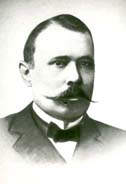 Jozef Morozewicz
Jozef MorozewiczOn February 18, 1921, Witos, the Prime Minister, and Przanowski, the Minister of Industry and Trade, signed a decree establishing the Statute of the Polish Geological Institute.
The beginning
In the early years of its existence, the Polish Geological Institute was housed in the Staszic Palace in Warsaw. Soon after its foundation, the Polish Geological Institute acquired a building plot in the Rakowiecka street. The architectural project was designed by Marian Lalewicz. Building works started in 1925 partly using monoliths from former orthodox church. These were pink granites from Kumlinge island, the Aland Islands, transported to the Hangö port and further to Warsaw. These elements greatly influenced the architectural ideas of Lalewicz who, along with the classicistic style of the institute's buildings, retained a basilica and cloister style of the inside. Building works of the southern "chemistry" pavilion started in mid 1925, and were completed in 1926. The main building, whose foundations were laid in 1923, was ready for partial use in 1930 when the final removal from the Staszic Palace occurred. Due to enormous financial problems, the main building was completed as late as in 1936, and the total cost amounted to 2,300,000 zloty.
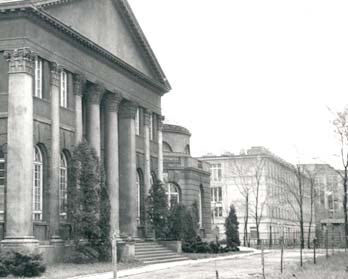 "Old Building" - main gate
"Old Building" - main gateThe first discoveries of mineral resources came in 1924 (Rudki hematite and pyrite deposit) and in 1925 (Rachów phosphatic deposit).
The first "Geological map of the Republic of Poland" (scale 1:750,000) constructed by Kuźniar was published in 1926, and the first "Map of natural resources of the Republic of Poland" (scale 1:750,000) produced by Czarnocki was issued in 1931.
The wartimes
War history of the Polish Geological Institute began on September 6, 1939, when some of the staff were evacuated to Lvov. Professor Karol Bohdanowicz also left Warsaw transferring the post of Director General to Józef Zwierzyniecki. During the siege of Warsaw, the PGI buildings were hardly damaged, except for the museum hall's roof and some of exhibits. In mid-September, 2 representatives of the Berlin Amt für Bodenforschung - Prof. Paeckelmann and Dr Barnitzke, arrived in Warsaw to sequestrate the estate and to take all valuable things away to Germany. After the estimates of damages they proposed that the Polish staff could be reemployed at the same job as before. Most of the staff returned to work in November 1939.
Reorganization of the Institute by the occupying authorities occurred in April 1940. Its name was changed to Amt für Bodenforschung, with the headquarter in Kraków. Professor Brinkman was appointed the Director General and fulfilled his dities until April 1944 when replaced by Professor Petraschek. The main tasks focused at those times on geological mapping and registration of natural resources. However, not all research results were revealed by Polish geologists and some of data were kept in secrecy. Many staff persons lost their lives during the war. 95% of the building mass and approximately 50 % of the equipment were destroyed. Losses within the museum collections were estimated 70%. Much of the library collection was sent to Germany, part of it was destroyed and burnt during the 1944 Warsaw Uprising. However, it was the staff that suffered most. At least 25% of the staff and co-operators were killed.
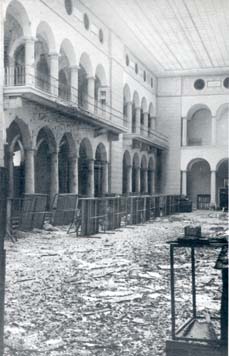
Geological Museum, main hall - 1945
The post-war restoration
Soon after liberation of Warsaw in January 1945, the first staff members visited the Institute's ruins. Unfortunately, they could not enter their jobs since the buildings were completely damaged. During the war much of the staff moved to Kraków, hence the post-war Polish Geological Institute was first reactivated in Kraków. All scientific materials, hidden in August 1944, were recovered. The undestroyed equipment and the buildings started to be restored in July 1945. Restoration works progressed fast and in Autumn 1946 the management was transferred to Warsaw.
In 1946 - 1947, the main building was restored. Director General, Jan Czarnocki, was planning to develop the buildings so that they could be large enough to meet the increasing demands on geological investigations. Anticipating further spontaneous development of geosciences in the new, post-war world, Czarnocki realized that the Warsaw headquarter had to possess another modern building allowing to develop broad-scale scientific researches. The new building of the Polish Geological Institute was designed by Prof. Marek Leykam. Building works started in 1948 and were completed in 1952.
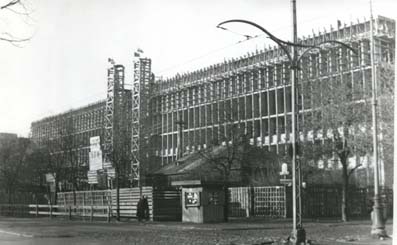
Construction of a new building
On April 23, 1959, a large erratic biotite gneiss block of Scandinavian origin, about 10 cubic metres, was laid at the main entrance. The block was found in 1938 during ground works in Warsaw.
Great geological discoveries
Just after the Second World War geologists from the Polish Geological Institute discovered a number of important mineral resources. Regional studies of rock salts in areas off the Carpathian Foredeep, already conducted before the war, resulted in the discovery of the Kłodawa salt diapir in 1947.
In 1952, Pawłowski together with a team of specialists discovered a sulphur deposit within Miocene rocks of the Carpathian Foredeep. It was the first worldwide known discovery of the Polish Geological Institute, which significantly influenced development of domestic economy giving rise to the sulphur industry.
One of the Europe's largest barite deposits was discovered near Stanisławów in the Sudetes in 1954. Its production started 3 years later.
The Fore-Sudetic Monocline has been an area of copper deposit exploration since 1955. The Copper Slate was drilled in the Sieroszowice IG 1 borehole in May 1957, giving rise to the discovery of the huge copper deposit and, as it appeared soon, also silver deposit. In 1959, these deposits were documented between Głogów and Lubin by a team directed by Wyżykowski, allowing the development of the copper industry in Poland
In the period of 1954 - 1960, gravity and drilling experiments performed by Werner resulted in the discovery of the Izbica Kujawska, Lubień, Łanięta, Mogilno and Damasławek salt diapirs.
Exploration, carried out by Ciuk in Miocene deposits of the Polish Lowlands (1952 - 1960), allowed to identify and measure a number of brown coal deposits (Adamów, Uniejów, Gubin, Mosty, Rogoźno), some of them of considerable reserves. In 1961 - 1975, specialists from the Polish Geological Institute explored and evaluated brown coal deposits from Bełchatów, Złoczew and tectonic grabens of Wielkopolska. Boreholes, drilled according to the Znosko's project in the vicinity of Krzemianka and Udryń, revealed the occurrence of vanadium-bearing ilmenite-magnetite ores.
The discovery of polyhalite deposits in the Gulf of Puck was a result of intense geological exploration in the period of 1964 - 1970. The most spectacular success in the energy resources field, however, was the discovery of the Lublin Coal Basin.
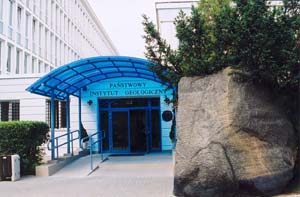
Polish Geological Institute today
The Polish Geological Institute is managed by the Director doc. dr hab. Jerzy Nawrocki. The Institute consists of the Warsaw Headquarter and 7 regional units:
Lower Silesian Branch in Wrocław,
Upper Silesian Branch in Sosnowiec,
Carpathian Branch in Kraków
Holy Cross Mountains/Świętokrzyski Branch in Kielce,
Pomeranian Regional Geology Unit in Szczecin,
Marine Geology Branch in Gdańsk-Oliwa,
Lublin Regional Geology Unit in Lublin.
In the last years, the PGI buildings have been renovated. In 1998, a new seat of the Marine Geology Brach was built in Gdańsk-Oliwa, while in 2000 - a new building of the Pomeranian Branch in Szczecin. Part of the Central Geological Archive was transferred to excellently equipped and organized, modern and spacious rooms.
A major modernization was performed to the Geological Museum in Warsaw. In 2002, a new collections store, located under the Main Exposition Hall, was completed. The space for the store was achieved using an underground mining method excavating the earth from beneath the building "C". Two modern equipped education and exposition halls was constructed. The Morozewicz Hall and the main entrance have also been modernized lately.
"New building" - main gate
Activity of the Polish Geological Institute has always been related to geological survey tasks. Starting from 1919, the Institute has been involved in scientific and research programmes supporting the geological survey operations. PGI was awarded the status of a National Research Institute by way of a resolution of the Council of Ministers of 24 February 2009. Discoveries of many mineral resources, a number of geological maps editions, monitoring of the abiotic natural environment - all these are examples of practical aspects of the Institute's activity. Science and duty - this is the specificity and the power of the Polish Geological Institute. Over many years, the Institute has acquired large technical means and considerably developed its databases. These advantages along with highly qualified staff allow to face the challenges imposed by the state authorities at the beginning of the 21st century.
by: Halina Urban, Marek Graniczny, Włodzimierz Mizerski
translated by: Krzysztof Leszczyński














 PGI-NRI offer
PGI-NRI offer Mineral resources of Poland
Mineral resources of Poland  Oil and Gas in Poland
Oil and Gas in Poland 




 Subscribe to RSS Feed
Subscribe to RSS Feed